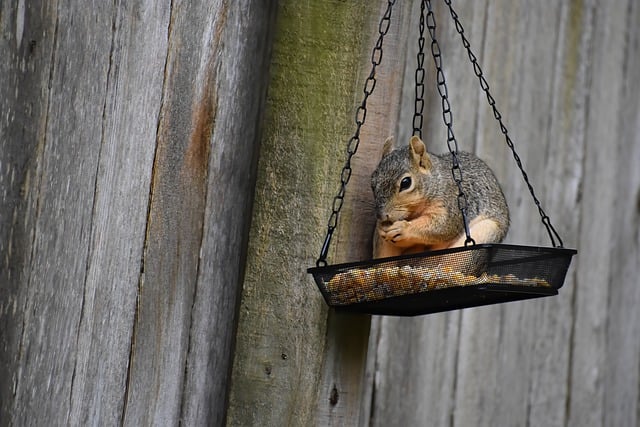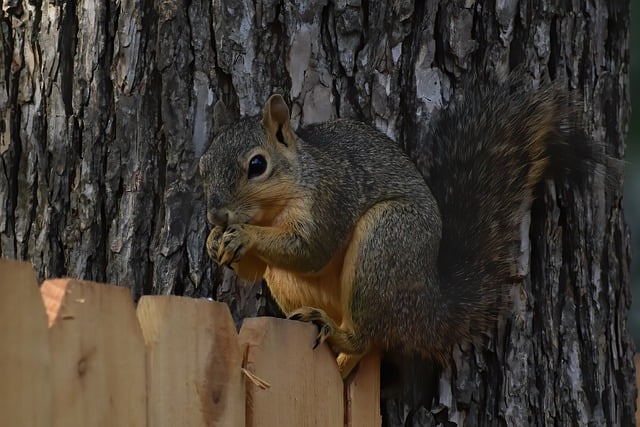Tucson’s Catalina Foothills Rodents: Habits, Impacts, and Control Strategies
In Tucson's Catalina Foothills, a variety of rodents coexist with human residents, each with u…….

In Tucson's Catalina Foothills, a variety of rodents coexist with human residents, each with unique behaviors and ecological roles. Effective rodent control Tucson strategies are essential to manage these populations, address property issues such as nesting and damage, and mitigate health risks like hantavirus. The region's ecosystem, including the Sonoran Desert, supports species like pack rats, deer mice, and kangaroo rats, with each playing a part in seed dispersal and maintaining plant populations. Pest management professionals employ an integrated approach that includes habitat modification, exclusion techniques, and targeted trapping or removal to provide rodent control solutions that protect homes while preserving the local ecosystem's balance. This nuanced approach ensures community safety and ecological harmony, making rodent control Tucson services crucial for sustainable coexistence within the foothills' diverse habitats. Homeowners are advised to maintain clean conditions, seal entry points, and use professional rodent control Tucson services for effective management of these pests.
In the Catalina Foothills of Tucson, Arizona, a diverse array of rodents play pivotal roles within the local ecosystem. This article delves into the intricacies of rodent behavior and habitat preferences in this region, offering valuable insights for homeowners and pest control professionals alike. By understanding the common rodent species present and their preferred habitats, we can better implement rodent control Tucson strategies to mitigate their impact on local environments and protect properties from infestations. Join us as we explore these small yet significant creatures and the measures necessary for coexisting with them harmoniously.
- Introduction to Rodent Behavior in Catalina Foothills
- Identifying Common Rodents in Tucson's Catalina Foothills
- Habitat Preferences of Rodents in the Catalina Foothills Region
- The Impact of Rodent Activity on Local Ecosystems
- Effective Rodent Control Strategies for Tucson Homeowners
- Professional Rodent Control Solutions in Tucson: Ensuring a Pest-Free Environment
Introduction to Rodent Behavior in Catalina Foothills

Rodents are a diverse group of mammals that play a significant role in the ecological balance of any region, including the Catalina Foothills of Tucson, Arizona. These creatures exhibit complex behaviors influenced by their environment and the availability of resources. Understanding rodent behavior is crucial for effective rodent control in Tucson, as it informs both preventive measures and control strategies. The Sonoran Desert’s unique ecosystem provides a rich habitat for various rodents, such as pack rats, deer mice, and kangaroo rats. Pack rats, known for their ability to climb and nest in high places, construct intricate nests that can become problematic in residential areas. Deer mice, while often harmless, can carry diseases like hantavirus, making their presence a concern for human health. Kangaroo rats, on the other hand, are adapted to arid conditions and play a key role in seed dispersal, contributing to plant population dynamics.
In the Catalina Foothills, rodents are not only a subject of ecological interest but also a common subject of rodent control inquiries for homeowners and businesses. The region’s varied habitats, from the foothills to suburban neighborhoods, provide both challenges and opportunities in managing rodent populations. Effective rodent control in Tucson requires an integrated approach that includes habitat modification, exclusion techniques to prevent access to structures, and, if necessary, humane trapping and removal. By understanding the specific behaviors and preferences of these rodents, pest management professionals can implement targeted solutions to protect homes, public health, and the delicate balance of the local ecosystem. This knowledge is essential for maintaining a harmonious relationship between the community and the natural world that surrounds them in the Catalina Foothills.
Identifying Common Rodents in Tucson's Catalina Foothills

In the Catalina Foothills of Tucson, Arizona, a diverse array of rodents coexist within the varied habitats that characterize this region. Identifying common rodents is a crucial aspect for both residents and pest control professionals in Tucson, as understanding these creatures helps in implementing effective rodent control measures. The most prevalent rodent species include the deer mouse (Peromyscus maniculatus), which can be found in a variety of environments from deserts to forests, making it adaptable and widespread throughout the foothills. These mice are typically harmless but can sometimes carry diseases harmful to humans, emphasizing the importance of rodent control Tucson. Another frequent inhabitant is the kangaroo rat (Dipodomys spp.), which is well-adapted to arid conditions and is often found in grassland areas with scattered shrubs. Its unique adaptations, such as large hind legs and powerful hind limbs for hopping, make it a distinctive part of the local ecosystem.
Rodent control Tucson is not only about removing these creatures but also involves preventing their access to human dwellings. The house mouse (Mus musculus) is also common in urban areas and can be found in residential neighborhoods within the Catalina Foothills. This small, gray rodent prefers to nest near food sources and is adept at squeezing into tiny openings to enter homes. Lastly, the Arizona pocket mouse (Chaetodipus pensylvanicus) is a less common but fascinating native species that resides in the region’s more remote areas. Its large pouches are used to carry seeds and nesting materials, and its preference for open desert environments requires different strategies in rodent control Tucson compared to urban-adapted species. Understanding the habits and habitats of these rodents is essential for effective coexistence and pest management, highlighting the importance of professional rodent control services in Tucson’s Catalina Foothills.
Habitat Preferences of Rodents in the Catalina Foothills Region

Rodents in the Catalina Foothills region exhibit distinct habitat preferences that reflect the diverse ecosystems within this area. These preferences are crucial for understanding the local rodent population’s dynamics and informing effective rodent control measures in Tucson. The Foothills, characterized by their mix of chaparral, grasslands, and wooded areas, provide a rich tapestry of habitats that rodents exploit to their advantage. Ground squirrels, for example, favor open spaces with abundant vegetation, while pack rats tend to prefer more secluded environments such as rocky outcrops and dense shrubbery. The presence of a reliable water source is another key factor influencing these rodents’ habitat selection, as it is essential for their survival.
Local fauna like deer mice and pocket mice also seek areas with ample shelter to construct their nests, often found in soil cavities or beneath debris. These habitats offer not only protection from predators but also proximity to food sources, which can include seeds, nuts, insects, and sometimes human-provided sustenance. Understanding these preferences is vital for implementing successful rodent control strategies in Tucson, as it allows for targeted interventions that respect both the environment and local wildlife. By comprehending the specific needs of each rodent species, pest management professionals can develop and execute effective solutions to manage rodent populations sustainably.
The Impact of Rodent Activity on Local Ecosystems

In the Catalina Foothills, rodents play a significant role in shaping the local ecosystems. Their foraging activities influence seed dispersal and vegetation dynamics, contributing to the maintenance of biodiversity within the region. These small mammals are also crucial participants in the decomposition process, as they help break down organic matter, which enriches the soil and supports plant growth. However, their impact can be double-edged; while beneficial for certain aspects of ecological health, rodent activity can sometimes lead to conflicts with human inhabitants, necessitating measures such as rodent control in Tucson. The burrowing behavior of rodents can compromise the integrity of structures and agricultural lands, potentially causing damage that requires intervention. Moreover, the presence of rodents can facilitate the spread of pathogens or vector-borne diseases, posing health risks to humans and domestic animals. Effective rodent control measures are thus essential to protect both human health and the ecological balance of the area. These measures should be implemented with care to minimize environmental disruption while effectively managing rodent populations to ensure they do not reach levels that could lead to uncontrolled proliferation or significant ecological disturbances.
Effective Rodent Control Strategies for Tucson Homeowners

In the Catalina Foothills region, homeowners in Tucson often face challenges with rodent infestations due to the area’s ample food sources and suitable habitats. Effective rodent control in Tucson necessitates a comprehensive approach that includes exclusion, sanitation, and population reduction. Exclusion involves sealing entry points where rodents can enter homes, such as gaps around pipes, utility lines, and vents. Regularly inspecting and repairing any potential access points is crucial to prevent rodent infiltration. Sanitation practices are equally vital; maintaining clean conditions, especially in kitchens and pantry areas, can reduce the attractiveness of homes to these pests. It’s important to eliminate or store food items properly, ensuring that crumbs and spills are promptly cleaned up to avoid providing a buffet for rodents. Population control may require trapping or the application of rodenticides by professionals, adhering strictly to safety guidelines to protect non-target species and pets. Homeowners in Tucson should also be vigilant about monitoring for signs of infestation, such as droppings, gnaw marks, or the sighting of rodents themselves. By combining these strategies, Tucson homeowners can effectively manage and mitigate rodent issues, ensuring a more pest-free environment. Engaging with local pest control services that specialize in rodent control Tucson can provide tailored solutions and guidance specific to the area’s unique challenges.
Professional Rodent Control Solutions in Tucson: Ensuring a Pest-Free Environment

In the Catalina Foothills, a region known for its diverse ecosystems surrounding Tucson, understanding rodent behavior and habitat preferences is crucial for effective rodent control solutions. The local wildlife, including species such as pack rats and deer mice, exhibit distinct patterns that can lead to conflicts with human habitations. Professional rodent control services in Tucson are adept at addressing these challenges by implementing a combination of strategies tailored to the unique environment. These experts utilize integrated pest management (IPM) practices that focus on long-term prevention and control while minimizing chemical interventions. By carefully inspecting homes and businesses, they identify entry points and potential food sources, sealing off accesses and removing attractants to deter rodents. Advanced trapping and exclusion techniques are employed to humanely manage populations, ensuring that both wildlife and property are protected.
For residents and business owners in Tucson, partnering with a reputable rodent control service is essential for maintaining a pest-free environment. These professionals bring a wealth of knowledge and experience, using the latest technology and eco-friendly methods to safeguard properties against invasive rodents. Regular monitoring and maintenance are key components of a comprehensive rodent control plan, providing peace of mind and preventing the damage that rodents can cause to structural elements, insulation, and stored goods. With an unwavering commitment to client satisfaction and environmental stewardship, these rodent control Tucson services ensure that the Catalina Foothills remain a harmonious blend of nature and human habitation.
In conclusion, the rodent community within Tucson’s Catalina Foothills exhibits distinct behaviors and habitat preferences that are integral to the local ecosystem. Homeowners in this region can benefit from a nuanced understanding of these creatures to implement effective rodent control Tucson measures. By recognizing the species commonly found in the area, such as deer mice and pack rats, and their preferred habitats, residents can take proactive steps to safeguard their homes and maintain a harmonious balance with nature. The strategies outlined in this article provide a comprehensive approach to rodent management, ensuring that Tucson’s Catalina Foothills remain a thriving environment for both wildlife and human inhabitants. With the right knowledge and professional rodent control solutions, maintaining a pest-free environment is attainable, thereby preserving the health and integrity of the local ecosystem.







